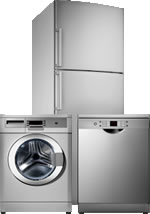How to Check the Dryer VentThe proper venting of a clothes dryer is critical. Most importantly for a gas dryer, it carries out toxic combustion gases, primarily carbon monoxide.The vent also carries warm, moist air out of the home. That moist air can lead to mold and damage to a home if not properly vented. Finally, because dryer lint can build up in the vent, an improperly maintained dryer vent is also a serious fire hazard.
A gas dryer burns a mixture of natural gas or propane and air. The resulting combustion gases of carbon monoxide and dioxide are created. These gases must be properly vented to the outdoors to prevent asphyxiation or poisoning. An improperly vented dryer can also result in the build up of lint which represents a fire hazard. A typical vent hose is about four inches in diameter. It can be made of rigid steel or aluminum, semi-rigid aluminum, flexible foil or flexible PVC / vinyl. The vent hose connects from the rear lip of the dryer to the lip of an exterior vent and should be held in place on both ends with a band clamp. The safest choice for a vent hose is a rigid metal. There are two reasons for this, first, the rigid metal eliminates the sagging that occurs in flexible venting. Sags allow lint to accumulate in the vent and represent a fire hazard. Second, the metal is not flammable and helps contain a fire if the lint does ignite. The down side to the rigid vent is that it is more difficult to connect to the dryer because it is not flexible. Because it is rigid, you must be able to connect it to the dryer with the dryer in place. A reasonable alternative is a semi-rigid aluminum vent. This material is fairly fire resistant and less prone to sagging. Because it is flexible, you can connect it to the dryer before moving the dryer into place. The foil coated and plain PVC / vinyl vent hoses are NOT recommended. These hoses are not fire resistant and are prone to sagging. Lint build up is a problem and if the lint catches fire, the vent hose burns too. In all cases, the venting you use should be of the shortest length possible and should be arranged so that no low points (in which lint can accumulate) exist between the dryer and the exterior vent. Use as few turns as possible and avoid sharp turns when possible. Each turn increases friction and reduces airflow which increases the risk of lint build-up. Periodically, you should inspect your venting to make sure that it is clear of obstructions, such as lint or rodent intrusion. Make sure there are no holes or tears. Inspect the exterior vent for obstructions such as plants, weeds or objects placed against the vent. It is also advisable to vacuum any lint that has accumulated beneath the dryer. This periodic maintenance will reduce the fire risk, and the risk of poisonous gases entering your home. Another benefit of clearing the vent line of blockages is that it will improve your dryer's performance and reduce operating costs. |
 |
|




